#daguerrotype
Explore tagged Tumblr posts
Text

Union soldier with his family during the American Civil War, ca. 1863-65.
Daguerrotype
Unknown Photographer
#reddit#historicalcapsule#electrical-aspect-13#1860s#1860#1864#1865#union solider#history#family#children#kids#siblings#sisters#blm#black history#black history month#daguerrotype#unknown photographer#b&w#military#civil war#american civil war
26 notes
·
View notes
Text
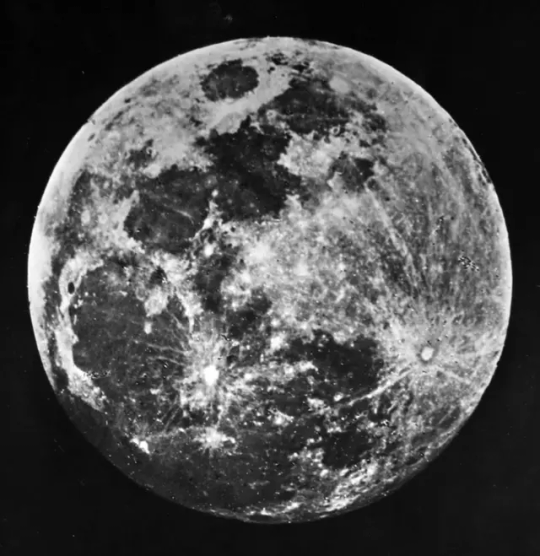
A daguerrotype of the full moon taken in 1840.
One of the first astronomical photographs ever taken, by Dr J.W. Draper of New York.
Photo by © Hulton-Deutsch Collection
#art#cosmos#cosmic#universe#blast#space#photography#vintage photography#moon#1840#daguerrotype#astronomical#Dr J.W. Draper#black & white
19 notes
·
View notes
Text

Lola Montez, 1851
44 notes
·
View notes
Photo

Kno-Shr, Kansas Chief, 1853 John Fitzgibbon (American, 1816–1882) Daguerreotype
3 notes
·
View notes
Text
Toevallige ontmoeting met dodelijke afloop
Het was niet eens de échte revolutie van 1848, die van februari, die een eind maakte aan het bewind van de ‘burger-koning’ Louis-Philippe en van Frankrijk weer een republiek maakte (de tweede, na de eerste tijdens de Franse revolutie). In juni van datzelfde jaar kwamen zo’n 20.000 Parijse arbeiders en handwerkslieden in opstand, omdat zij zich verraden voelden. In februari had de massa gestreden…

View On WordPress
#1848#1851#algemeen kiesrecht#Ateliers nationaux#ballingschap#barricade#Bastille#Brest#Commune van Parijs#daguerrotype#duel#Emmanuel Barthélemy#Engeland#Faubourg du Temple#Faubourg Saint-Antoine#februari 1848#Frankrijk#Frédéric Cournet#Guernesey#Guernsey#Herzen#Horace Vernet#juni 1848#Jusqu&039;à ce que mort s&039;ensuive#Ledru-Rollin#Les misérables#Londen#Louis Blanc#Louis Blanqui#Louis-Philippe
0 notes
Text
"The Rebels of Reason: Defying Media's Grip"
"The Rebels of Reason: Defying Media's Grip"
In the heart of a bustling metropolis, there existed a small but tightly-knit community that had long been immune to the unrelenting tide of mass media's influence. The people of this community were known for their resistance to conformity and their deep commitment to critical thinking. In their minds, they found solace in the wisdom of the great philosophers and the values of humanism that had guided their lives for generations.
The community was nestled amidst towering skyscrapers and flashing billboards that endlessly proclaimed the latest trends and opinions. The media's cacophony of sensationalism and conformity seemed never-ending. However, these resilient individuals, led by a wise elder named Sophia, sought refuge in the teachings of great thinkers like Socrates, Kant, and Voltaire. They held true to their belief that the pursuit of knowledge and individuality was the essence of life.
Sophia was the guiding light of their resistance. She was a woman of great intellect and a firm believer in the power of reason and self-expression. Her humble abode was a sanctuary for those who sought solace from the constant bombardment of sensational headlines and trends that threatened to engulf their society.
One evening, as the sun dipped below the horizon and cast an amber glow over the city's skyscrapers, the community gathered at Sophia's home. Her walls were adorned with the works of great philosophers and humanists, and they served as a constant reminder of the principles that guided their lives.
Sophia addressed the assembly, her voice filled with a quiet resolve. "My friends," she began, "our world is filled with noise, with narratives that try to mold our minds and steer us towards conformity. But we must remain steadfast in our commitment to individual thought. We must not allow ourselves to become mere echoes of the media's whims."
The group nodded in agreement, their faces illuminated by the soft glow of candlelight. They understood that their unique thinking was a rebellion against the shallow world of sensationalism and the never-ending quest for popularity.
Over time, the community's values began to spread like ripples in a pond. They inspired others to think critically, to question the status quo, and to embrace their individuality. The media, however, saw them as a threat to their control over public opinion and attempted to discredit and suppress their ideas. But the more they were persecuted, the stronger their resolve became.
The teachings of philosophy and humanism fueled their determination to persevere. They held true to the idea that knowledge, reason, and compassion were the foundations of a just and free society. Their small community became a beacon of light in a world that often seemed consumed by darkness.
As the years passed, their message of critical thinking and humanism continued to spread, reaching even the most skeptical corners of society. They proved that, in a world drowning in media's cacophony, the power of individual thought, guided by philosophy and humanism, could triumph. And, one by one, hearts and minds began to awaken, drawn by the allure of authentic thought and the promise of a brighter, more enlightened future.
Andrea Bigiarini
0 notes
Text

Rethinking Fashion Photography
The dawn of fashion photography took place after Louis Daguerre (1787-1851) made the first daguerreotype featuring people, View of the Boulevard du Temple, in 1838. This breakthrough sparked a proliferation of such images, with snapshots of actresses, dancers and debutants, spreading awareness of the new technology.
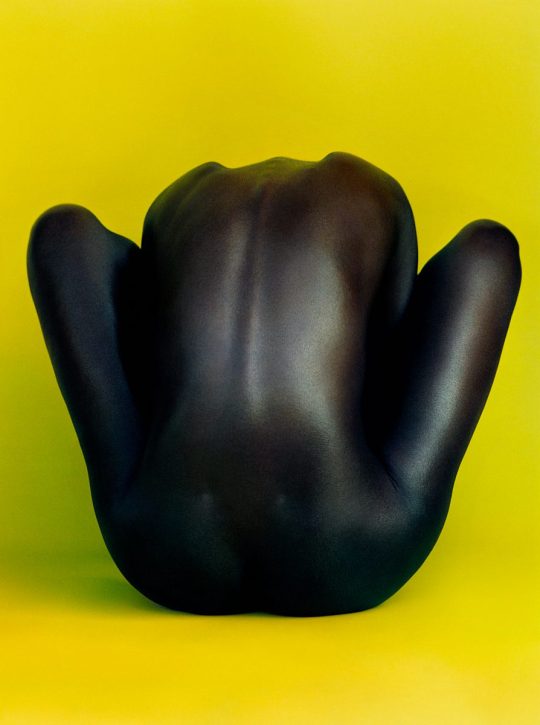
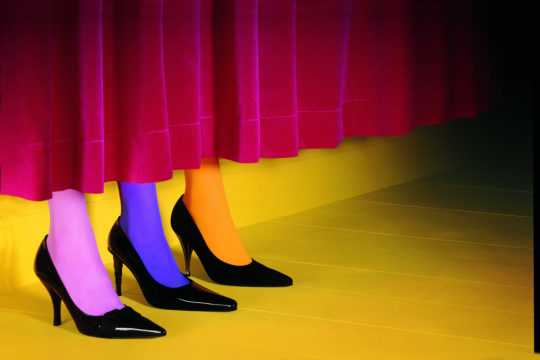


0 notes
Text
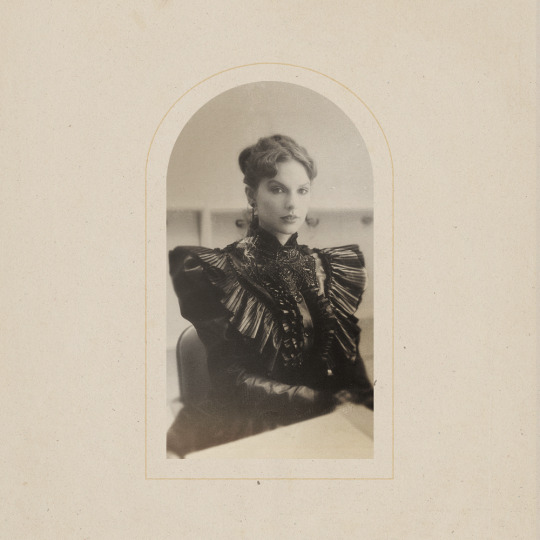
948 notes
·
View notes
Text

another submission for the @theterrorfebruaryflash <33
Mrs. Tom Blanky returned from expedition to her lovely wife and they went to get a new daguerreotype <33
#the terror#thomas blanky#the terror amc#Esther blanky#girl navy#gender swap#my art#it was fun adding little details that daguerrotypes have sometimes#like foil elements and blush#the terror February flash
51 notes
·
View notes
Text


i keep forgetting to mention this, but btw i do have a PRINT SHOP!! ✨✨
not much is up there just yet (mainly because everything else i've tried to put up so far has had the wrong specs 😭) but i DO have lots of plans for upcoming & future prints (plus other merch!) to make and add that i'm very very excited to share with you all 💖
#����#john irving#cornelius hickey#the terror#the terror amc#hickeyirving#my art#merch#solving on the turret stairs will be a print for sure but idk yet what else#girl navy daguerrotypes perhaps!!
46 notes
·
View notes
Text

Edward Dembowski (born May 31st, 1822) was the eldest son of Leon Dembowski, a senator and affluent landowner. As a student, he discovered the works of Hegel; he published his first essay in 1841 and soon, aged twenty, became the editor of Przegląd Naukowy ("The Scientific Review"), which was at the time one of the most prominent left-wing newspapers in Warsaw. Greatly influenced by the French utopian socialists of his day, Dembowski, a staunch democrat, equated national liberation with the liberation of the common people, speaking out against both the conservative Polish aristocracy and liberal bourgeois-reformist circles. Though officially Tyssowski's secretary and subordinate, he was the de facto leader of the Kraków Uprising of 1846.
Dembowski was shot by Austrian troops on Feburary 27th, 1846; the wound was lethal, he died on that same day; he was twenty-three.
As his radical political views contrasted with his noble background, Edward Dembowski earned himself the nom-de-guerre of "czerwony kasztelanic" ("red castellan's-son" - his father was a castellan).
Today marks the 202nd anniversary of his birthday. (On that note: here is my translation of a poem Wisława Szymborska wrote about him.)
#Output#My art#Edward Dembowski#History#Portrait based on his contemporaries' description of him first and a daguerrotype reproduction second
11 notes
·
View notes
Text
Discovered 3/4 thru this paper that there's a way fucking cooler paper topic nested in it. Could bail and write that instead but I've chosen the superior option of adding either a 3-page footnote or alternatively just throwing in a four page aside. Who Give A Shit
#[scholar of relevance redacted] literally does this with like every article he writes he fucks off in the middle of talking abou#t daguerrotypes to talk about random poets etc and people loooove himmmmm. admittedly he was tenured and then prof emeritus#but whatever. i am giving myself official permission to stop talking about B*rgson for a few pages in order to make some dubious claims#about rooting pre-cinematic film theory in [poet redacted]'s writing on nature and god-time. There's A Connection. [charlie day dot png]
2 notes
·
View notes
Text
the only birth anything i've given any character is a birth year (the other guys retain dean's birth year of 1917 in my mind). I suppose that dude was born in the 1840s...probably 1841-1842 or so depending on when in the 1880s rio bravo is
#typewriter dings#i'd like it to be the mid 1880s that way there can be at least one daguerrotype of a baby dude from the early 1840s...#(they would've been expensive and dude isn't from a rich family very clearly so one is me being hopeful)#dude
4 notes
·
View notes
Text

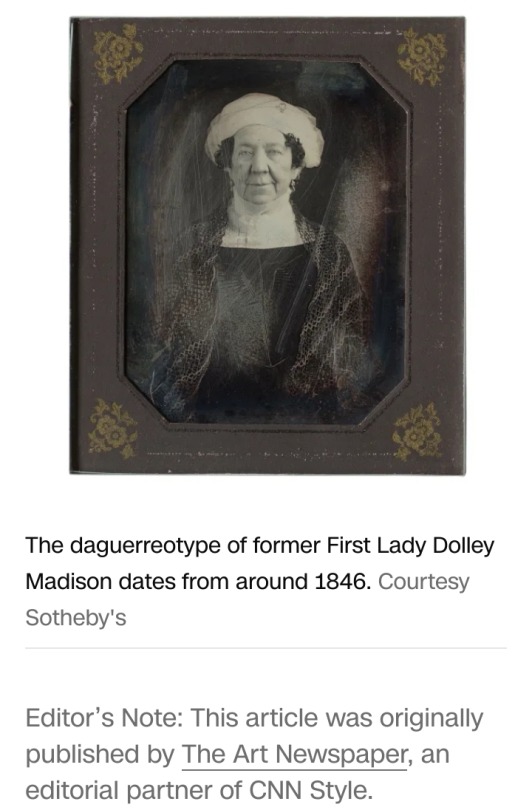







—
Dolley Todd Madison (née Payne; May 20, 1768 – July 12, 1849) was the wife of James Madison, the fourth president of the United States from 1809 to 1817.
She was noted for holding Washington social functions in which she invited members of both political parties, essentially spearheading the concept of bipartisan cooperation.
Previously, founders such as Thomas Jefferson would only meet with members of one party at a time, and politics could often be a violent affair resulting in physical altercations and even duels.
Madison helped to create the idea that members of each party could amicably socialize, network, and negotiate with each other without violence.
By innovating political institutions as the wife of James Madison, Dolley Madison did much to define the role of the President's spouse, known only much later by the title First Lady — a function she had sometimes performed earlier for the widowed Thomas Jefferson.
—
James Madison (March 16, 1751 – June 28, 1836) was an American statesman, diplomat, and Founding Father who served as the fourth president of the United States from 1809 to 1817.
Madison was popularly acclaimed the "Father of the Constitution" for his pivotal role in drafting and promoting the Constitution of the United States and the Bill of Rights.
#The Smithsonian#National Portrait Gallery#US First Lady Dolley Madison#US President James Madison#quarter-plate daguerrotype#daguerreotype#John Plumbe Jr#Sotheby's#Louis Daguerre#photographic process#photography#first lady#1800s#19th century
3 notes
·
View notes
Text
Confined Spaces
"Confined Spaces: Philosophical Reflections on Boundaries, Freedom, and the Human Experience"
Introduction
Confined spaces, typically regarded through a pragmatic lens of occupational safety and engineering, hold an intriguing capacity to inspire philosophical contemplation. Beyond their utilitarian purpose, they offer a canvas upon which we can paint profound philosophical reflections about the human experience, the concept of boundaries, and the yearning for freedom. This article embarks on a philosophical journey into confined spaces, exploring the existential, metaphysical, and ethical questions they provoke.
The Nature of Boundaries
Confined spaces, by definition, define boundaries. They are spaces that delineate the boundary between the internal and external worlds. This concept of boundaries, both physical and metaphorical, resonates deeply in the realm of philosophy. It raises questions about the arbitrary nature of boundaries and the symbolism they carry. Gaston Bachelard's "The Poetics of Space" comes to mind, where the boundaries of confined spaces take on poetic and emotional significance.
In philosophy, boundaries signify limitations, restrictions, and, in some contexts, oppression. Yet, confined spaces highlight a paradoxical relationship with boundaries. While they physically restrict, they also offer liberation. They serve as vessels for exploration, evoking a sense of freedom. By choosing to enter these spaces, we actively push the boundaries of the known and explore the uncharted.
The Philosophy of Freedom
The existentialist philosophers, such as Jean-Paul Sartre and Albert Camus, would find the concept of confined spaces a fascinating subject. They argue that true freedom comes from embracing our responsibilities and confronting the limitations of existence. Entering confined spaces is a choice, a conscious decision that carries inherent responsibilities and risks. This mirrors the existentialist notion that we create meaning and freedom in our choices, even within constrained circumstances.
The Human Yearning for Exploration
Confined spaces are emblematic of the human desire to explore the unknown. From the depths of the Earth to the far reaches of outer space, we venture into confined, uncharted spaces driven by a primal curiosity. This exploration is not merely a scientific endeavor; it is an existential quest. It mirrors our deep-seated yearning for understanding, novelty, and transcendence. In exploring confined spaces, we embark on an existential journey of self-discovery and expansion of our collective knowledge.
Confronting Fear and Vulnerability
Confined spaces often evoke fear, vulnerability, and uncertainty. Philosophically, these emotions represent a valuable opportunity to confront our limitations. We must face our fears and vulnerabilities, and this confrontation can be seen as an existential exercise. It challenges us to embrace uncertainty, resilience, and the potential for personal growth. Such philosophical musings resonate with the works of existentialist philosophers who assert that we find authenticity when we confront fear and vulnerability.
Environmental Ethics
Philosophers in the realm of environmental ethics can view confined spaces as microcosms of ecosystems. These spaces offer a unique perspective on the delicate balance between human intervention and the preservation of nature. They prompt discussions about our moral obligations to protect these spaces, given their vital ecological functions.
Conclusion
In conclusion, confined spaces, often perceived as practical, are profound metaphors for philosophical exploration. They lead us to question the nature of boundaries, the concept of freedom, the human desire for exploration, and our capacity to confront fear and vulnerability. Philosophically, they exemplify the idea that our interactions with these spaces can be transformative, reflecting the depths of our existence and the boundaries we choose to push. Ultimately, confined spaces not only keep us safe but also inspire us to explore the boundaries of our own understanding and the human experience.
All the images are copyright by Andrea Bigiarini 2023 - All rights reserved.
0 notes
